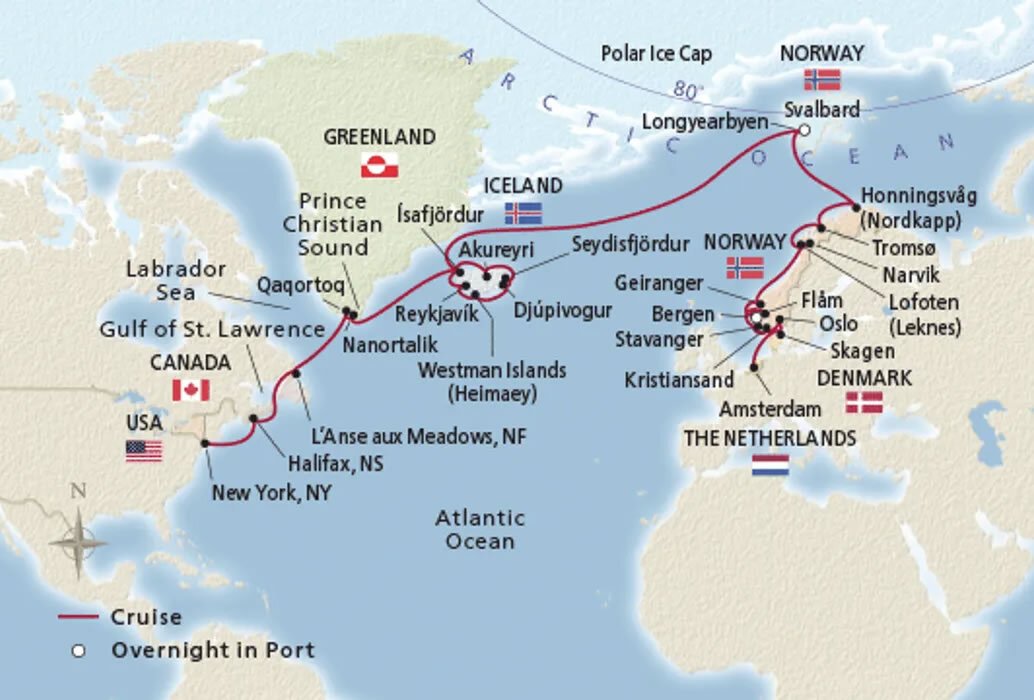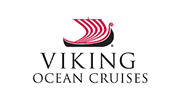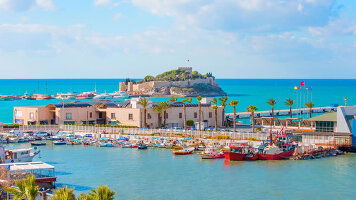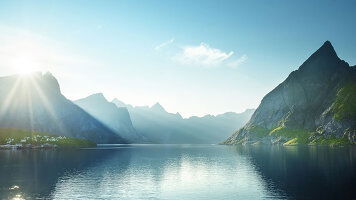Overview
Itinerary
Embark your ship and settle into your stateroom. New York City is at once romantic and exhilarating. From the robust streets of Lower Manhattan's financial district to the intimate warrens of Greenwich Village, the city overflows with culture, cuisine and architectural beauty. New York is for everyone. Music lovers marvel at Carnegie Hall or catch a 1920s-style jazz and blues show in Harlem. Romantics board a horse-drawn carriage in Central Park. Art lovers browse the Museum of Modern Art or the Guggenheim. And theatergoers attend the greatest shows in the world on Broadway, amid the glitter of Times Square.
Sail the Atlantic Ocean, divided in half, north to south, by the Mid-Atlantic Ridge. Longer than the Rockies, the Himalayas and the Andes combined, this underwater mountain range is the longest on Earth. As you sail, explore our well-curated Library, tucked in a private alcove of the Living Room, and select from a broad range of titles. Read a book by the Main Pool, a calming oasis in any weather with its retractable roof, allowing for year-round swimming.
Halifax exudes a fine European air and lies along the edge of the Atlantic Ocean. Visitors by sea are greeted by the 1758 Sambro Island Lighthouse, the oldest surviving beacon in North America. In the harborside Historic Properties district, grand and charming stone buildings built in the 18th and 19th centuries grace the cobblestone streets. The city grew up around Citadel Hill, where Fort George protected the harbor. The fortress, along with the adjacent stately Halifax Town Clock, has been gloriously restored and preserved.
Follow in the footsteps of 10th-century Vikings and sail the vast Gulf of St. Lawrence, an outlet for the North American Great Lakes into the Atlantic Ocean via the St. Lawrence Seaway. As you sail today, attend an informative lecture or watch a film in our state-of-the-art theater. A range of insightful TED Talks and desination-inspired seminars are offered daily.
L'Anse aux Meadows is the site of the first Norse settlement in the Americas. Leif Eriksson's voyage from Greenland in the late 10th century predated Columbus by 500 years. Proclaimed a UNESCO World Heritage Site in 1978, the ancient village Eriksson founded provides fascinating insight into the day-to-day lives of Vikings. Each of its dwellings was constructed of a wood frame covered in sod. The site was uncovered in 1960, when a village local pointed out a series of mounds in the earth that he and his neighbors had always believed to be an ancient Native American camp.
Follow in the footsteps of intrepid Viking Leif Eriksson who famously crossed this stretch of water to become the first European to land on North American shores. Meet fellow guests and listen to the soothing sounds of classical music in the Living Room, an ideal setting for relaxation. Enjoy a cup of coffee or sip on a refreshing cocktail.
Qaqortoq is a repository of Viking, Inuit and Danish history. Greenland's largest and best-preserved Viking settlement lies 12 miles out of town at Hvalsey, established by Erik the Red's uncle in the 10th century. The Inuit soon followed, and left behind many artifacts from their early days. The Danish colonial era, too, is finely reflected in historic buildings, including an 1804 blacksmith's shop and the harborside 1797 black tar log building. Qaqortoq lends itself to leisurely strolls and its spectacular setting attracts outdoor enthusiasts.
Nanortalik is nestled on an island near the mouth of a fjord on the southwestern shores of Greenland. It was established in 1770, though a small group of Vikings led by Erik the Red first arrived in the 10th century and called it “Grœnland,” or Greenland, in hopes of attracting more settlers. Today, the Inuit people dominate this austere and picturesque landscape and hold fast to their long Inuit traditions by fishing for crab, hunting hooded seals and welcoming visitors with a festive kaffe-mik, a coffee party with plenty of their famed Greenlandic cake.
Sail legendary waters, where medieval Europeans believed “there be dragons” beyond the ocean's horizon. Renew your body, mind and spirit in our Scandinavian-inspired Spa, a Nordic sanctuary of holistic wellness, today while at sea. Whether you unwind in the Sauna, refresh in the Snow Grotto or take a dip in the Thermal Pool, you will feel recharged and revitalized.
ĺsafjördur was founded in the 9th century by the Viking Helgi Magri Hrólfsson. Foreign merchants arrived in the 16th century and set up trading posts here. Today, ĺsafjördur is home to one of the largest fisheries in Iceland and, despite its remote locale, boasts a cultural scene rich in music and drama. The oldest house in Iceland is here, built in 1734, as is the country's largest concentration of old timber-frame homes. Many visitors explore farther afield, delving into the surrounding wilderness of Hornstrandir or discover the fishing heritage of charming coastal towns.
Nicknamed the “Capital of the North,” Akureyri is set at the end of the Eyjafjördur and enjoys a mild climate, unusual for a northern city just 62 miles from the Arctic Circle. Folk culture is robust in Akureyri; the Vefarinn dance was invented here to celebrate the harvest. Other points of pride include the Public Park and Botanic Garden, where some 2,000 plant species grow, and the hilltop Akureyrarkirkja, the local church that is home to a stained glass window from Coventry Cathedral in England.
Seydisfjördur enjoys a mountainous setting at the end of a fjord. It traces its origins to the early days of Viking settlements. Though the town is tiny, it boasts an impressive history. It hosted the world's first modern whaling station and pioneered international communications when it welcomed the first telegraph cable, linking Iceland to Europe. Colorful wooden homes line the streets, overseen by starkly picturesque slopes and the soaring summits of Mounts Bjólfur and Strandartindur.
Djúpivogur lies on Iceland's east coast and has been a trading center since the 16th century. The town is presided over by the towering Búlandstindur; a mountain famed in local folklore for its ability to grant wishes during the summer solstice. Dotted around the town, several cultural sights can be explored, including The Tank and the Eggs of Merry Bay. Residents here favor embracing a slower pace of life. The town has adopted the cultural trend known as “Cittaslow” which is dedicated to the promotion of sustainable living, improving the quality of life for its residents.
Heimaey is the only populated island in the Westman Islands. The scenery is stunning with its volcanic landscapes, moss-covered clifftops and picturesque homes with brightly colored rooftops. A number of breathtaking natural sights are a result of the volcanic eruption that took place here in 1973, which saw the evacuation of all 5,000 residents to the mainland. Each summer, millions of puffins pay a visit and countless other species migrate here to feed and breed. Several efforts are underway to protect the wealth of wildlife, from puffins to the gentle giants of the sea.
Reykjavík is the world's northernmost capital city yet captures the distinctive feel of a fishing village. The Kentucky-sized island is Europe's westernmost nation and one of the wildest places on earth. It is also lauded as one of the cleanest and most civilized countries, committed to finding the perfect balance between day-to-day living and harnessing its natural resources with eco-friendly practices. Vikings landed on this pristine land during the 9th century; their arrival is well chronicled in the medieval Sagas preserved at the Culture House.
Ísafjördur, nestled at the foot of dramatic mountain slopes, is the capital and largest settlement on the Westfjords, a large peninsula in northwestern Iceland that is connected to the mainland by a wide isthmus. This rugged, unspoiled region is home to landscapes of breathtaking natural beauty, from jagged mountain peaks, to red- and gold-sand beaches, cascading waterfalls and Drangajökull, Iceland's only expanding glacier. The Westfjords teem with birdlife; Látrabjarg, located on the peninsula's western shores, is the site of one of Europe's largest bird cliffs.
Journey to what was once believed to be the “end of the world,” where sea monsters lurked and ships were lost on treacherous waters. As you sail today, savor a range of international cuisine on board. Choose from a variety of international flavors at the World Café, enjoy al fresco dining on the Aquavit Terrace, or regional specialties in The Restaurant.
Explore the stunning beauty of the Svalbard archipelago, hundreds of Norwegian islands halfway between Norway and the North Pole. Stunning panoramas unfold here—dramatic fjords lead into glimmering bays surrounded by massive glaciers and rugged peaks cloaked in snow. The austere tundra unfolds to an Arctic desert where polar bear, Arctic fox and reindeer roam. Many regions have been designated Important Bird Areas by BirdLife International for the countless winged creatures that breed and hunt along the coast. Its endless wonders can be explored by zodiac, kayak and land.
Svalbard's setting is marked by stunning fjords, mountain peaks and thick glaciers that have formed over millennia, while Alkhornet mountain and its looming cliffs date back more than one billion years. Wildlife flock to this stark landscape during the summer—puffins, polar guillemot and kittiwake descend en masse each year. The Svalbard Museum showcases the vast array of special plant and animal life that reside here, as well as everyday life for its human residents, from the arrival of the whalers during the 17th century to present-day miners.
Named for 16th-century Dutch navigator and polar explorer Willem Barentsz, the Barents Sea is the gateway to the Arctic from the northernmost shores of Europe and home to an astonishing diversity of marine life. As you sail, take advantage of the array of delicious cuisine offered on board. You may visit Mamsen's, our casual gourmet deli, any time from early morning to late at night for a taste of traditional Norwegian fare. Or, dine at Manfredi's and savor an authentic Italian meal, with options ranging from Milanese risotto to Tuscan inspired classics.
Honningsvåg overlooks a pristine bay of the Barents Sea on Magerøya Island. This unassuming enclave grew mainly on the fishing industry, like so many in this remote region. Honningsvåg has ample charms, including a rich Sami culture and a deep love of the birdlife that lives here. But it is the surrounding beauty that draws visitors: starkly beautiful tundra dotted with mountain birch trees, distant rocky islands and rolling slopes that ascend into mountains. One of Europe's most stunning natural sights, Nordkapp, or North Cape, rises on the island's rugged northern coast.
Tromsø is Norway's most northerly city and has long been considered the gateway to the Arctic. During the summer months, pretty wooden houses exude an air of sophistication as they bask beneath the glow of the Midnight Sun. Winter brings pristine landscapes surrounded by snowcapped peaks and the aurora borealis, whose magical lights dance across the nighttime skies. World-renowned explorers have set sail from Tromsø's shores; Roald Amundsen, Norway's first son and the first explorer to reach both poles, is commemorated with a bronze statue in the city.
The Lofoten Islands stretch 118 miles into the Norwegian Sea from Norway's coast. Ships in the archipelago's cozy fishing harbors are dwarfed by the hulking massifs rising from the waters. The setting was ideal for Norse settlements in the early Viking Age. Cod has long been harvested from these waters as they come here to spawn. More recently, the fish have been caught from traditional rorbus, charming cottages that hover above the waters on stilts. The Lofoten Islands are beautiful any time of year, but the summertime midnight sun illuminates their magnificent glory.
Narvik is situated on the innermost shores of the Ofotfjorden, within the Arctic Circle. The small town enjoys a dramatic backdrop, encircled by mountains and a glacier that spills right to the water's edge. The town served as a port city for the early Viking settlers. Much later, the discovery of iron ore in the nearby Swedish town of Kiruna forever shaped Narvik. Kiruna needed a year-round ice-free port from which to ship its new discovery, and so a rail link was built directly to the water. Still today, Narvik is a major exporter.
The Norwegian Inside Passage is a protected shipping lane that runs from Norway's capital of Oslo, down the Skagerrak coast and around the country's southern tip. It continues north along the coastline of the Norwegian Sea, before eventually terminating in the Russian waters of Siberia. It has been used by mariners for centuries, its channels protected from the dangers of the open water by countless skerries and the rugged coastline presenting opportunities for shelter in its many natural bays and inlets.
Geiranger is the gateway to some of coastal Norway's most magnificent natural treasures. Nearby, the Seven Sisters Waterfall tumbles 1,000 feet into the fjord's water, while directly across the fjord, the Suitor Waterfall also plunges down a steep face. The overlook known as Eagle's Bend towers 2,000 feet above the village, accessed via a winding mountain road with 11 hairpin turns. The Norwegian Fjord Center puts all this natural splendor into perspective with fascinating exhibits.
Bergen is home to the Hanseatic League's only kontor (trading enclave) still in existence. Bryggen wharf, a row of timbered Hanseatic warehouses along a quaint quay, is a UNESCO World Heritage Site. Narrow wooden walkways are flanked by parallel rows of small, vibrantly painted buildings overlooking the picturesque Vågen Harbor. This is perhaps the most charming district of Bergen and a delight to explore, from its tight-knit community of workshops where artisans sell their wares to its cafés where freshly prepared smørbrød, or open-faced sandwiches, are on the menu.
Bergen, an ancient city with deep Viking roots, is nestled between gargantuan snowcapped mountains, magnificent fjords and one of Europe's largest glaciers. Founded in 1070 on what was a Viking settlement, Bergen is the second-largest city in Norway. Not to be missed is a stroll through the Fisketorget, where the fresh catch of the sea awaits—from cod and prawns to local caviar and icy oysters.
The charming village of Flåm sits eight hours inland through the breathtaking Aurlandsfjord. It is world-renowned as one of the world's most spectacularly scenic places and the gateway to sprawling green valleys dwarfed by towering peaks. These primeval mountains, glacial lakes and glorious waterfalls were sculpted during the Ice Age. The landscape around Flåm is dramatically steep and the town is the starting point of the world-renowned Flåm Railway, which chugs through the magnificent scenery of Norway, past roaring waterfalls and breathtaking vistas.
Stavanger is home to one of Europe's most interesting Old Towns. The cobblestone streets of Old Stavanger, or Gamle Stavanger, are lined with the continent's highest concentration of wooden buildings that date to the 17th and 18th centuries; approximately 250 are protected by a conservancy formed in the 1950s after developers threatened to destroy these cultural riches. Stavanger profited from an offshore oil drilling boom in recent decades; buoyed by its energy sector, the once-placid city gained a cosmopolitan flair and was honored in 2008 as European Capital of Culture.
Kristiansand boasts tidy streets, cozy harbors and small-town charm. The town's Viking past can be traced in the runestones at the Oddernes Church, built in 1040 and dedicated to St. Olaf, patron saint of Norway. In the 17th century, King Christian IV ordered the Christiansholm Fortress to be built to defend the newly founded city. Today, the edifice is adjacent to an inviting harborside boardwalk. The city's rich traditions are embodied in the old wooden houses of the Old Town and the stunning neo-Gothic cathedral.
Oslo is one of Scandinavia's most vibrant cities, set on a splendid bay amid stunning fjords and hills. It was founded by a Norseman, King Harald III, and has grown over the centuries around the cherished Akershus Fortress. The city not only has a rich Viking past with its close ties to the sea, it also boasts an impressive artistic heritage. Perhaps its most famous painter is Edvard Munch, whose work The Scream is known the world over. But Gustav Vigeland's 200 or so sculptures are the most prominent works in the city, on full display throughout Vigeland Park.
Skagen is a charming old seaside village nestled amid pristine dunes, picturesque moors and long sand beaches. During the Middle Ages, Skagen was known for its herring catch, and remains a major fishing center today. With the introduction of the railway, a group of impressionist painters discovered the area's seascapes and soft evening light and journeyed here to found the Skagen Painters; their work is showcased at the small Skagens Museum. The lure of Skagen inspired royalty to visit: King Christian X was so taken with the setting that he built a summer residence here.
Cross the North Sea, where Vikings sailed as they established colonies on Scottish islands, coastal France and beyond. Enjoy the amenities of your ship as you sail. Perhaps take a breath of fresh air on a brisk walk around the Promenade or begin your day with a workout in the well-equipped Fitness Center.
A city of charming canals, elegant gabled houses, splendid museums and abundant bicycles, the Dutch capital of Amsterdam is a delight to explore. Its patchwork of waterways forms about 90 islands connected by 1,500 bridges. The legacy of the Dutch Golden Age lives on in gilded manses and in the lush paintings of Rembrandt and other Dutch masters that adorn the Rijksmuseum, The Netherlands' grand repository of art and cultural history. Discovering Amsterdam is a pleasure best pursued on foot; visitors line the tranquil canals and linger over Dutch pancakes, or take a stroopwafel to go. After breakfast, disembark your ship and journey home.

Trip Reviews (1) Most Recent 'Grand Fjords & Iconic Viking Shores' Reviews
Download Brochure
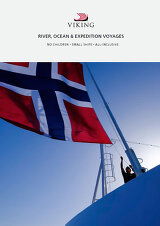
Viking River, Ocean & Expedition Voyages (2025-27)
Dates & Pricing
 USD
USD
Viking Cruise $25 Deposits!
Cabin Layout Options:
Select Cabin Preference:
Tour & cruises prices are per person. Prices shown have savings applied, are subject to availability and may be withdrawn at any time without notice. Pricing and trip details are correct at this point in time, however are subject to confirmation at the time of booking and are subject to change by Viking. For cruise itineraries, cabin images are sourced from the cruise-line and should be treated as indicative only. Cabin inclusions, upholsteries and room layout may differ to the image(s) shown depending on the ship selected and your sailing dates.



